Must haves for your first RV Park adventure.
What you should have to Hook-up Services
I’d like to talk about the things you must have before you can go camping or spend a night in your RV. Lets begin with your electrical hook-up. Whether your RV is a 30 amp or 50 amp connection, you won’t have any power without the right cords and adapters to plug into an electrical current. Lets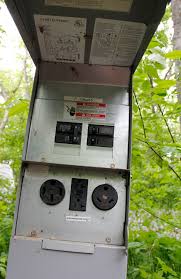 assume you are going to an RV Park or Resort and you will have Power, Water, and Sewer hook-ups. You want to make sure your RV is equipped with an electrical plug designed for your system. Most modern Motorhomes have a 30 amp or a 50 amp service. If your RV is equipped with one air conditioner on the roof and a propane fridge and stove, then chances are you have a 30 amp service.
assume you are going to an RV Park or Resort and you will have Power, Water, and Sewer hook-ups. You want to make sure your RV is equipped with an electrical plug designed for your system. Most modern Motorhomes have a 30 amp or a 50 amp service. If your RV is equipped with one air conditioner on the roof and a propane fridge and stove, then chances are you have a 30 amp service.
With a 30 amp service you probably wouldn’t want to run too many appliances with the air conditioner on. I usually would turn the air off if I made coffee or toast just to be sure not to trip a breaker. Sometimes it depends on the Park and how old their system is. The compressor on an air conditioner draws a lot of power every time it turns on and off. When it 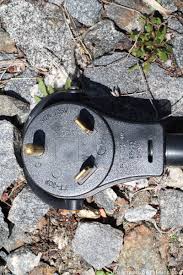 reaches the temperature you have set it at, it will turn off until the temperature goes up, then come on to cool it down again. This puts quite a load on the system and if you are running another appliance that requires a lot of power it may be too much and trip a breaker. Some RV Parks have breakers on the power box outside where you plug in. If the Coffee maker, toaster and AC trip the electricity, its no fun getting dressed to run out and reset the breaker before you’ve even had your coffee.
reaches the temperature you have set it at, it will turn off until the temperature goes up, then come on to cool it down again. This puts quite a load on the system and if you are running another appliance that requires a lot of power it may be too much and trip a breaker. Some RV Parks have breakers on the power box outside where you plug in. If the Coffee maker, toaster and AC trip the electricity, its no fun getting dressed to run out and reset the breaker before you’ve even had your coffee.
If your Coach has 50 amp service you shouldn’t need to worry about much. When I am plugged in to 50 amp, everything works even if I run them all at the same time. A 50 amp plug and wire are bigger than the 30 amp and 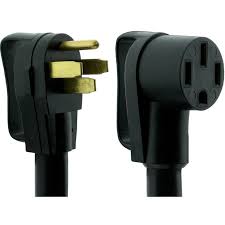 have a much higher gauge wire inside. This allows much more power to pass through without getting hot or tripping a breaker. I have learned that you should test your RV to see what the limits are when you are in a Park that has easy access to the breakers. If you trip one you can easily fix it. Having 30 amp power is not a bad thing. You just need to work around your limits. Once you have been out a couple of times you will know what you can and can’t do all at the same time.
have a much higher gauge wire inside. This allows much more power to pass through without getting hot or tripping a breaker. I have learned that you should test your RV to see what the limits are when you are in a Park that has easy access to the breakers. If you trip one you can easily fix it. Having 30 amp power is not a bad thing. You just need to work around your limits. Once you have been out a couple of times you will know what you can and can’t do all at the same time.
Now that we have covered a little bit of how it works, what do you need to add to your RV essentials checklist. The first thing you need to look for is the electrical cord with a 30 or 50 amp plug on it. Sometimes it is just a thick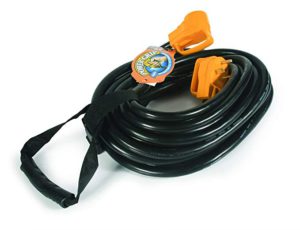 extension cord with large male and female ends on it. It may be a permanently attached wire on the RV and only have a male end on it. If you can, try to get the previous owner or salesperson to show you where it is or where it plugs in to the RV. Everything electrical is usually in a compartment on the drivers side of your rig. If there is no chord you will need to buy one.
extension cord with large male and female ends on it. It may be a permanently attached wire on the RV and only have a male end on it. If you can, try to get the previous owner or salesperson to show you where it is or where it plugs in to the RV. Everything electrical is usually in a compartment on the drivers side of your rig. If there is no chord you will need to buy one.
My RV has a 50 amp chord, but I keep an extra 30 amp chord and a 50 to 30 amp adapter in case the Park doesn’t have 50 amp service or all those sites are taken. If I plug in to a 30 amp receptacle I will still be able to run an air conditioner, lights, TVs and some appliances without too much trouble. This will also keep my batteries charged while I am plugged in. I would suggest buying an extra 30 amp cord even if you already have one just in case you need the extra length at some time. I also keep a 75 feet outdoor 3 pronged household extension cord just in case I am somewhere that I can only plug into a traditional household receptacle. I may or may not get the air to work but I can use the lights, TVs and small appliances. This too will keep my batteries topped up and its nice to not have to worry about that. For this to work you will need to buy a 30 amp to 110 adapter so you can use a regular household wall plug if there’s nothing else available. I like to boondock a lot and many times I have found a 110 plug with power that is available to use and I was so thankful for all the extra chords I brought along. Last is a Power Surge protector. Some RV Parks were built awhile back and may not have all the modern protections a newer Park will have. We carry a lot of electronics with our RVs and its always wise to have some heavy duty surge protection. You can buy small plug ins or get a box to protect the whole RV. I have a big one and have never had any problems.
conditioner, lights, TVs and some appliances without too much trouble. This will also keep my batteries charged while I am plugged in. I would suggest buying an extra 30 amp cord even if you already have one just in case you need the extra length at some time. I also keep a 75 feet outdoor 3 pronged household extension cord just in case I am somewhere that I can only plug into a traditional household receptacle. I may or may not get the air to work but I can use the lights, TVs and small appliances. This too will keep my batteries topped up and its nice to not have to worry about that. For this to work you will need to buy a 30 amp to 110 adapter so you can use a regular household wall plug if there’s nothing else available. I like to boondock a lot and many times I have found a 110 plug with power that is available to use and I was so thankful for all the extra chords I brought along. Last is a Power Surge protector. Some RV Parks were built awhile back and may not have all the modern protections a newer Park will have. We carry a lot of electronics with our RVs and its always wise to have some heavy duty surge protection. You can buy small plug ins or get a box to protect the whole RV. I have a big one and have never had any problems.
Getting Water
On the drivers side of your RV you will see a water intake. It may be inside a small door or in one of the lower storage areas outside. It is usually locked to avoid contamination. You will have a fresh water tank under your Rig that needs to be filled up with potable water. These tanks are usually somewhere from 30 to 100 gallons depending on the size of your RV. I keep mine topped up all the times in case I boondock somewhere without services. Its extra weight to carry around but you will be happy to have it if you get stuck somewhere and end up running out.
To fill this tank up you will want to be sure you will be using potable water unless you are using pre-bottled or larger bought water jugs for drinking. For drinking water we use the refillable 16 liter jugs you can buy at the grocery store then return for a full one. It is better for the environment not to use cases of plastic water bottles, but that’s up to you. If you trust that your fresh water tank doesn’t contain anything that could hurt you or if it is new then put your drinking water right in there and drink it. There are special hoses that you can buy that are just for that purpose. They are usually white and will say they are for potable water use when you buy one. I keep two of these hoses in my Rig just in case it might be a long way to the spigot. I find using two 25 ft. hoses better than one 50 ft. hose. If the hook-up is close then I don’t have 35 ft. of extra hose to trip over, if I just use one hose. If its far, then I have lots. When I put them away I always thread the ends of each hose together to keep out bugs and contamination.
to use cases of plastic water bottles, but that’s up to you. If you trust that your fresh water tank doesn’t contain anything that could hurt you or if it is new then put your drinking water right in there and drink it. There are special hoses that you can buy that are just for that purpose. They are usually white and will say they are for potable water use when you buy one. I keep two of these hoses in my Rig just in case it might be a long way to the spigot. I find using two 25 ft. hoses better than one 50 ft. hose. If the hook-up is close then I don’t have 35 ft. of extra hose to trip over, if I just use one hose. If its far, then I have lots. When I put them away I always thread the ends of each hose together to keep out bugs and contamination.
Even though I don’t really drink water from my tank I do the best I can to keep it clean and filter it a couple of times before it comes out of the taps. I have an inline filter that hooks up on my hose and directly to the tap I am 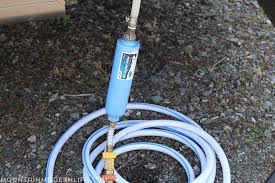 getting water from. There is another permanently mounted filter just outside of where the hose goes into the tank as well. In my kitchen I have a drinking water tap the previous owner installed and it has a third filter on it. I feel it is clean enough to brush my teeth but I don’t drink from it. You can buy replacement filters that may be changed every three or four months or once a season depending on how much water you use. I like to buy the best filters and hoses I can, to be sure we aren’t getting any kind of contamination. These filters and replacement filters can usually be bought where you would buy your hoses at Amazon or at any Walmart.
getting water from. There is another permanently mounted filter just outside of where the hose goes into the tank as well. In my kitchen I have a drinking water tap the previous owner installed and it has a third filter on it. I feel it is clean enough to brush my teeth but I don’t drink from it. You can buy replacement filters that may be changed every three or four months or once a season depending on how much water you use. I like to buy the best filters and hoses I can, to be sure we aren’t getting any kind of contamination. These filters and replacement filters can usually be bought where you would buy your hoses at Amazon or at any Walmart.
What goes in must come out
Now that we covered how to get the water into your RV its time to cover what you need to get the dirty water out. Under your RV on the Drivers side, or in a compartment, you will find a plastic pipe. with tiny nipples near its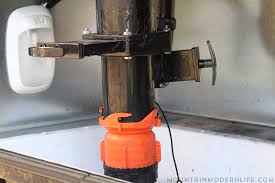 opening. This is the sewer drain. There are usually two pipes leading into the one drain. Each of these pipes will have an open and close valve on them. They are usually marked “pull to open, push to close” and Grey Water or Black Water. Usually hidden away from Pets and Children you will find a flexible hose that fits onto the pipe and turns, to be secured by the nipples on the drain. If you do not have a new sewer hose with your RV I would suggest you get one. If you have a used hose and you can not be sure of the age or condition it might be in I would replace it. This is not a hose you want to fall off or split while you are draining your tanks. I would also suggest getting some disposable plastic or rubber gloves for doing this chore.
opening. This is the sewer drain. There are usually two pipes leading into the one drain. Each of these pipes will have an open and close valve on them. They are usually marked “pull to open, push to close” and Grey Water or Black Water. Usually hidden away from Pets and Children you will find a flexible hose that fits onto the pipe and turns, to be secured by the nipples on the drain. If you do not have a new sewer hose with your RV I would suggest you get one. If you have a used hose and you can not be sure of the age or condition it might be in I would replace it. This is not a hose you want to fall off or split while you are draining your tanks. I would also suggest getting some disposable plastic or rubber gloves for doing this chore.
The sewer hose you need is a flexible hose and can be lengthened or shortened by squeezing it together or pulling it apart. I have lots of room in my storage bays so I have two that I can join together if needed, but its 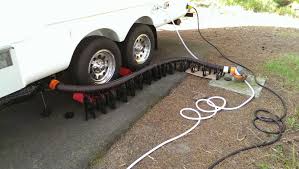 more for convenience. On your Camp Site you will have a receptacle for power, a spigot for your water hose and a sewer drain close to the ground. You need to hook up the sewer hose to the drain on the RV by pushing the hose over it then turning it until it locks in place. You then lay it across the ground and into the sewer drain on the ground. Always be sure to not put too much of your hose into the drain as that could cause the main drain under the ground to plug up.
more for convenience. On your Camp Site you will have a receptacle for power, a spigot for your water hose and a sewer drain close to the ground. You need to hook up the sewer hose to the drain on the RV by pushing the hose over it then turning it until it locks in place. You then lay it across the ground and into the sewer drain on the ground. Always be sure to not put too much of your hose into the drain as that could cause the main drain under the ground to plug up.
Your RV has two used water tanks. One is a Grey water tank and the other is a Black water tank. When these become full they need to be drained. If you are staying in a Park you can just leave them in the open position and let them drain through the hose to the sewer drain instantly. Some people like to let the tanks hold the sewage until it has some volume then drain them. This allows the sewage to build up some momentum to reach the ground drain when you do open them. This is a suggestion and I will leave it up to you. If you do have quite a bit of volume in your tanks and want to drain them then make sure you have a good connection on your hose. You do not want any leakage. The Black tank is your toilet water. Pull the stop slowly out on the pipe marked Black water and let it drain until you hear it stop running. You might then want to pick the hose up off the ground, closest to the RV first and force any sewage sitting inside the hose to drain into the ground sewer. Now push the stop closed and slowly open the Grey water pipe. The Grey water is any water that goes down your sink, shower, washing machine or dishwasher if you have one. It would be a lot cleaner than the Black water so doing it last will clean out your hose quite a bit.
When you are done camping it is always smart to unhook your sewer hose from the RV first and run some clean water through it and into the ground drain to clean it out. I use a old piece of garden hose for this so as not to contaminate my good water hoses. Always store your sewer hose somewhere that it cannot contaminate things you may come in contact with. A lot of RVs have a tube to insert it into for safe storing. One more good thing to have is Black Tank deodorizer. Add it to your toilet any time it begins to smell.
Conclusion
We have covered the essentials you will need to overnight in an RV Park with services. These are just the RV Essentials you must make sure your Rig has to enjoy a comfortable night in a Park. I will be covering more RV Essentials that will make your stay easier and more comfortable in future posts. Below is a list of the things that we covered in this post. I really hope you find this helpful.
Click on any of the links below to see the
Hook-up Essentials on the Checklists.
RV Essentials Checklist #1
- A 30 OR 50 AMP Power cord with a plug if you don’t already have one attached to your rig.
- An extra 30 or 50 amp extension cord.
- A 50 to 30 amp adapter if you have 50 amp service.
- A 30 to 15 amp adapter for traditional household current in case that’s available.
- A long heavy duty outdoor 15 amp extension cord for hard to reach places where there is no 30-50 amp services.
- Plug in surge protectors or one big surge protector for the whole RV.
RV Essentials Checklist #2
- one or two sanitary potable water hoses.
- one inline, tap to hose water filter.
- one large water filter just before the tank fill.
- optional inline filter on drinking water tap.
RV Essentials Checklist #3
- One or two flexible sewer hoses.
- Plastic or rubber disposable gloves.
- Black Tank deodorizer.
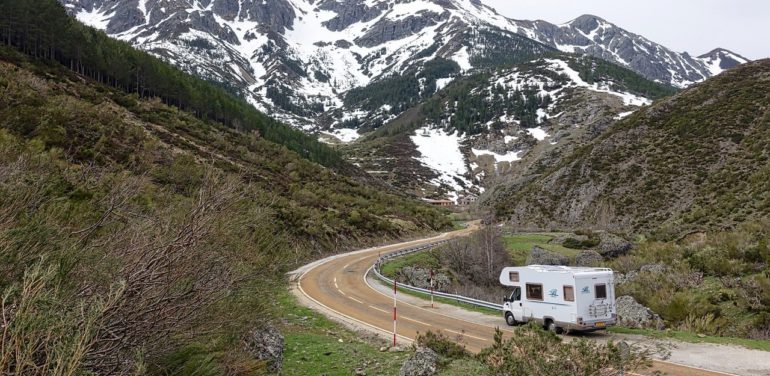
There is no doubt this post is very detailed and Informative. This is a thorough and insightful content. There are so many useful tips on this page that I had to bookmark in order to checkback and gain extensively from the writeup.These are lovely and befitting suggestions and i would make sure i implement. Thanks for the eye opener
Hi Hussaain…Thank you for your kind comments. I am so glad this was helpful. These comments make it all worth while. Thanks again
Dick
Hey there,
I’ve really enjoyed reading this article as you’ve provided us with lots of valuable information. Believe it or not, but I actually live in my RV. It just saves me so much money when it comes to accommodation.
In my opinion, I think that 50 AMPS would be good for a guy like me because of the fact that I’m always on the road. It’s much more flexible and better. Would you recommend anything robust than this? I wanna share this blog with my other friends who travel with their RV.
Thank you for taking your precious time in writing this detailed blog post. Keep up the good work!
Hey there and thank you for your questions and comments. I would suggest looking in to solar power with a 3000 watt inverter and Battle Born batteries for power storage. With a system like that you wouldn’t even need to plug in and would save a fortune being able to Boondock. Thanks again for your kind comments
This is a helpful article on RV essentials and I have bookmarked it. As I am of the age where not much is guaranteed except death at some point in the too near future, I am looking at changing to a lifestyle of RV living. I do have memories of my parents and their beautiful years crossing Canada and the USA in an RV.
I could not relate all those years ago, but I can now. Of course, having little knowledge other than small talk and seeing mechanical repairs taking place too often, I do not have a good picture if what it is really like traveling around North America in an RV.
But this article did add some credence to my thoughts that before I decide to go this route, I need to do some planning…This is where you have helped immensely…If I am to make it more than a dream, I have to plan carefully and make sure that all is in place…
Thanks for this post. I have bookmarked and will be back, I want to learn more. That is what I have done all my life, take calculated risks, and this one (traveling in an RV for the rest of my life) seems like a worthy endeavor, and one possibly full of adventure as well! Your checklist has helped immensely!
Hi Dave… Thank you for sharing your thoughts and story. We have a lot in common. I am 66 yrs old and would love to be on the road full time. The Nomad RV Lifestyle is really taking off. I would love to take two 3 month trips every year to the southern States and follow a comfortable temperature around. I live in Canada and the winters are getting tough for me so any break would be welcomed.
I have started writing articles on RVs and have many more to come. I bought a Van for camping when I was 20 and slowly worked my way up to a 40 ft. diesel pusher. I am sharing these experiences in my posts so they may be helpful for you when you do your planning. I will be adding more as I have a lifetime of information in my head and I might as well put some use to it.
If you have any questions or need my opinion on anything, please don’t be afraid to ask. As you can see I love to talk and tell stories. Thanks again Dave, I really enjoyed your comments and story.
Dick
This post is very explicit Wright. Its is one of the most insightful piece I’ve read on RV and its constituents. Though, I have a RV myself which I mostly use whenever my family and I are going for a Camping. I never truly imagined nor place so much attention as to the various essentials of the RV. I just stick with the basics.
Now, I am inside the RV while reading the post to check and tick for the presence of all the essentials and I’m ticking my check list. This post is very well structured and enlightening. Thanks for this post.
Thank you so much for your kind remarks. This kind of recreation is really taking off. A lot of businesses are adding spaces for overnight RV parking because not only sleep there but we spend our money there as well. Casino’s are all making room for RV’s and even some grocery stores have an RV area. Sometimes the adventure is the Journey, not the destination. Thanks again
Dick
Good checklist and thank you for sharing. I will appreciate it more if you can add some more in those checklist as you have just shared some essentials and not everything. I’d like to ask about the suspension system, are there any specifications to what kind of suspension works best in recreational vehicles? I mean, something like VSE Dynamic Bus Suspension, which is a hybrid and has a anti-dive function. Do we need something like that in an RV? Me and my partners are about to convert several public utility buses here into RVs and are thinking of what suspension should be installed.
Hi Gomez… Thank you for your questions. This was supposed to be a checklist for a new owners first night out at an RV Park with Utilities. What you would need to Hook-up. I will try to make that make that more clear. Thank you.
Buses are the new trend in RV life. I am following some builds now and haven’t seen anyone mess around with the suspension too much. The flat nosed rear engine 8.3 Cummins bus seems to be the most popular for builders and already comes with an air ride suspension. Depending on the bus size, if you stay within the recommended weight you should be good. I have seen some builders add air bags and a compressor to the front engine models to soften up the ride.
If I were building buses I would buy all the rear engine diesels I could find before everyone is doing it. Some people like a steel bus wrapped around them as opposed to the composite of an RV. The savings is another good reason. I hear the demand for these school buses is going up fast which means the prices will start to skyrocket as well. Good luck in your business. It is definitely in demand and you should do well.
Thank you for your interest and questions.
Dick
Amongst all these RV essentials you listed here, I’m personally keen at keeping my RV stocked with basic supplies, nonperishable foods, linens, and clothes, which makes me ready to go anytime, anywhere. RVs, give you the freedom to be spontaneous. Everyone has favorites and must-haves they can’t survive without. Before I leave home, I try to be sure to balance my load and not to overpack. Thanks for this generous article.
Thank you so much. I agree 100%. I will cover that in the future but I was hoping to explain what would be needed to use the Utilities an RV Park offers for the first time owner of a Motorhome. Thanks again for sharing your experience and your kind comments.
Dick
sincerely, I don’t know what RV is I have read the article from beginning to the end but from my own observations on the content, the contest has indept about your explanation and explicit as well, I will be glad to read ur future post on any content. Thanks for sharing your thoughts on this
Hello Ibrahim…. Thank you for your honest comments on my post. An RV is what we refer to as a Recreational Vehicle or Motorhome. I am adding some pictures to make it easier to see what I am explaining and to understand the Topic. You have helped me realize that what is common for me in Canada may not be for others elsewhere. Thank you for that.
Dick
Hi, Dick and Corinne, and thanks for this very informative and down-to-earth article on how to cover all the essentials for a night or two on an exciting adventure in nature. My husband and I have friends that live the “RV life” but most of the time, our idea of “roughing it” consists of a tent, sleeping bags, and a campfire with our 2 dogs, under the stars.
You certainly did explain everything in detail as to what someone would need to spend a few nights of freedom and comfort in an RV park. The only thing that was missing from your article was some pictures! Thank you for sharing your knowledge and expertise with us.
Sue
Thank you Sue for your kind comments…. I am adding pictures now and hope that will help visualize what I am talking about. Thanks again